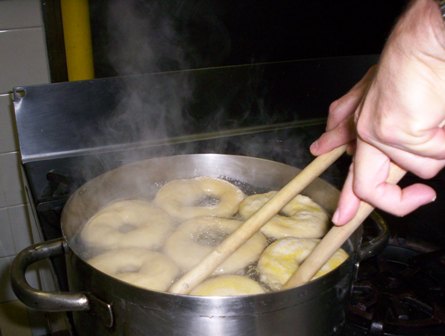Artisan bread is best described by thinking about the person who makes the bread. An artisan baker is a craftsperson who is trained to the highest ability to mix, ferment, shape and bake a hand crafted loaf of bread. They understand the science behind the chemical reactions of the ingredients and know how to provide the best environment for the bread to develop. How to tell a true hand crafted bread from one that is just called artisan. First look at the ingredients. There shouldn't be anything in bread besides flour, water salt and yeast. If the bread is made with a sourdough there may not even be yeast in the ingredients. Flavored breads may list other recognizable ingredients like nuts, garlic, herbs or cheese. All of the ingredients should sound like familiar foods. Remember you are buying one of the oldest most basic foods there is. It wasn't necessary to add chemicals to bread for centuries and it still isn't.

There are so many reasons why bagels are so popular. They are inexpensive, filling, appeal to health-conscious eaters because of their low-fat, high protein profile and they can be sweet or savory. But it is the history that the bagel truly comes into its own. It's widely agreed that bagels came to the United States from the Jewish shtetls of Eastern Europe, experts can't pinpoint the exact origin of the humble bread with the hole in the middle.
The world's first bagel was produced in 1783 as a tribute to Jan Sobieski, King of Poland. The king, a renowned horseman, had just saved the people of Austria from an onslaught by Turkish invaders. In gratitude, a local baker shaped yeast dough into the shape of stirrup to honor him and called it the Austrian word for stirrup, beugel. The roll soon became a hit throughout Eastern Europe. Over time, its shape evolved into a circle with a hole in the center and its named was converted to its modern form, bagel.

Bagels came to New York in the 1880s, with the immigration of hundreds of thousands of Eastern European Jews. Vendors used to thread the hole-shaped bread onto dowels and hawk them on street corners. The pronunciation of the word never changed, but the spelling was Americanized to bagel. In 1907, the International Bagel Bakers Union was founded in New York City. Members of the elite group, which was only open to sons of union members, fiercely safeguarded the recipe for bagels, which were usually boiled or "kettled" in vats of boiling hot water before baking. Bagel makers traditionally worked in teams of four, with two men making the dough and shaping the bagels, one boils them, and the fourth baking them.
The two most well-known styles of traditional bagel in North America are the Montreal bagel and the New York-style bagel. The Montreal bagel contains malt and egg but no salt; it is boiled in honey-sweetened water before baking in a wood oven; and it is predominantly either of the “black seed” (poppy) or “white seed” (sesame) variety. The New York bagel contains salt and malt and is also boiled prior to baking in a standard oven. The resulting New York bagel is puffy with a noticeable crust, while the Montreal bagel is smaller (though with a larger hole), chewier, and sweeter. In addition to the plain bagel, variants feature seasoning on the outside, including sesame, garlic, poppy seed, onion, rye, and salt. The “everything” bagel is a mixture of all of the above.
The bagel has come a long way and is now part of everyone’s everyday culture. Its constant reincarnation insures that it will stay and be desired by all who try it. Today bagels are no longer an "ethnic" food as millions of Americans embrace the breads as a healthful breakfast choice or snack.
Food Pictures by Jerusha DeVargas
Jan Sobieski, King of Poland provided by commons.wikimedia.org